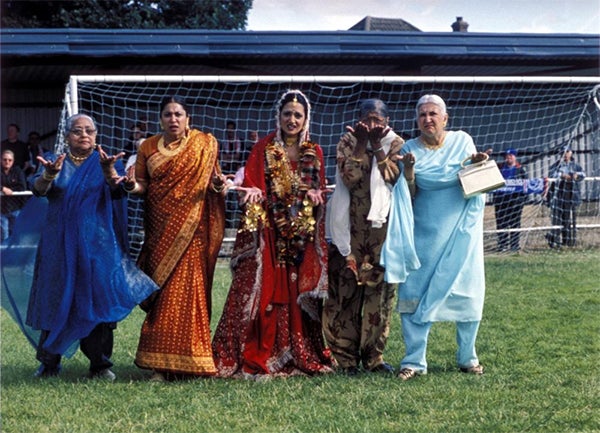
Growing up, I would watch TV shows and movies where all the characters were white. I wondered if people who looked like me were allowed to exist on screen. On the rare occasions where someone that looked like me was depicted, they would be a token character just there for the accent and subtle racial jokes.
There has been a boost in recent years to cast people who look like me. This was making my childhood dream come true except for one slight issue: only men were getting star roles. Sure, Hollywood is a sexist industry where male actors get more attention than their counterparts, but it’s really emphasized in the South Asian demographics.
When it comes to South Asian male representation there is something qwhiteoff about it. Aziz Ansari’s Netflix show Master of None was the first critically acclaimed series that starred a South Asian as the main character. Aziz’s character was a “forward thinking” son of immigrant parents. Throughout the show he would dismiss his parents’ culture in favor of his white peers’ lifestyle. Their culture was too antiquated for his American traditions and he never really made an attempt to embrace it.
Somehow, the only characters that are allowed to be represented are ones that dismiss their parents’ culture and embrace the American way of life. Instead of using their platforms to explore the internal struggle that diasporas have with balancing the two, they just skip over that and go full American. Is it because the only palatable South Asian is one that is white washed?
The trend of “white washing” these South Asian characters continues in Kumail Nanjiani’s film The Big Sick, a true story based on he and his wife’s life. Kumail is often found dismissing his Pakistan culture when it suits him. Often he would lie to his parents about praying, he would drink alcohol, have premarital sex, and, the worst offense of all, he prefered ice cream over kulfi. Yet he still uses his culture as a prop for his one person play, which comes across as if he doesn’t care about his culture all that much.
While these male South Asian diaspora characters are praised by society for their American lifestyles, female South Asian diaspora characters like Mindy Kaling are criticized for it. When Mindy Kaling’s character on the show The Mindy Project was dismissive of her parents’ Hindu rituals and cultures, she was met with criticism over belittling the religion. Contrast this to the praises and support that Aziz’s episode about dismissing his parent’s Muslim rituals and culture on Master of None received. Critics called that and Kumail’s secular views of Islam as inspiring and relatable. Mindy’s character was called out for being too white-washed yet Kumail was cheered on for pleading with his parents to allow him to be American.
Why do male diaspora get a pass on being white washed yet female diaspora face the brunt of criticism?
On the topic of female South Asian characters, representation outside of The Mindy Project has left a lot to be desired. There are no female South Asian led movies or shows, besides The Mindy Project and Priyanka Chopra’s Quantico.Female South Asian characters are shown as a prop in these male South Asian starred shows and movies.
During Master of None, there was not one South Asian female character in the first season. Possibly due to criticism, Aziz decided to include two of them in the next season. He goes on a Tinder date and is simply amazed. They weren’t what he stereotypically thought of South Asian women, instead they were like typical Americans. They drank alcohol, watched wrestling, dated, traveled, etc. But this was short lived because they were just used as a prop to show how diverse his love life was. These dates were stuffed into one episode so Aziz’s character could return to being in love with his Italian friend Francesca. These brown women was just used to emphasize how much he belonged with Francesca.
Representation for South Asian women gets even worse in The Big Sick. Throughout the film Kumail’s mother would set him up with female suitors and every single one of them was used as comedic element. There was a sweet girl who decided to try to bond with Kumail over their mutual love of The X-Files, but instead of coming across as endearing, she is portrayed as creepy and cringy. There was another suitor shown who was listing all the types of bread products she couldn’t eat while Kumail looked miserable.
Just as in Master of None, these women were used as nothing but a prop to make Kumail’s girlfriend, Emily, look leaps and bounds better.
When he began to lose hope with these suitors, one emerged that tried to impress Kumail with a magic trick. He was impressed and interested enough to even linger on her headshot before he put her in the box of suitors headshots. Yet that was all dismissed because he was in love with his white girlfriend. He went out and said several times in the film that he couldn’t see himself marrying a Pakistani woman. Even though all of these women appeared to be very American in their interests and personalities, they weren’t good enough for his American life.
The biggest double standard in the film was when he questions the magic trick suitor’s desires to settle down, even though Emily had the same desires. It was acceptable for Emily to want to settle down, but not these brown women.
The biggest offence to the female South Asian characters, including non-suitors, was the forced “stereotypical” accents. Even his mother and sister-in-law had accents while Kumail did not even though he came to America when he was 14. One of the suitors was born in America and never left the country yet she still had an accent. The accent came off as symbol to show how backwards these South Asian women were compared to Kumail.
A counterpoint to all of this poor representation of South Asian women is the movie, Bend It Like Beckham. A film that featured a South Asian women who is in limbo trying to balance her modern British lifestyle with her parents’ Punjabi lifestyle. This movie was a more accurate portrayal of the struggle diaspora face. Her parents’ culture wasn’t made to look antiquated or backwards in order to make the British lifestyle look better.
South Asian lead shows and movies are becoming more common, but is it really representation for South Asian people? It’s been 15 years since Bend It Like Beckham and there has been no female South Asian led movie while there have been countless male leads. When these female characters do show up in movies or shows they are either used a punch line or as a prop to appease critics and meet some diversity criteria. So while South Asian males are getting their representation and stories being told, women are getting the brunt of the stick. How can we celebrate representation if it means brown women are being used as a joke?
The overall consensus amongst brown women is that we are not mad at these movies and shows representing interracial relationships between a brown man and a white woman. We are just disappointed that we are being dragged into these relationships to make the white women suitors look better.
At the end of the day, I rather we not be “represented” at all, than being used as a prop in these films and shows.
